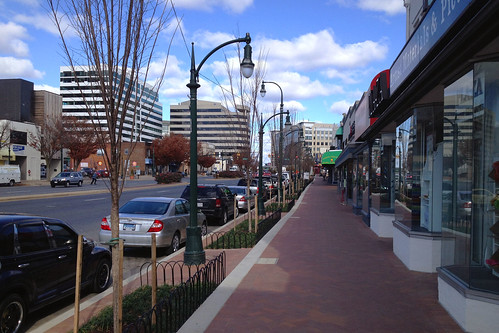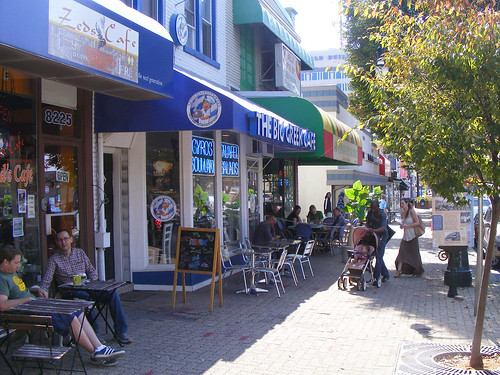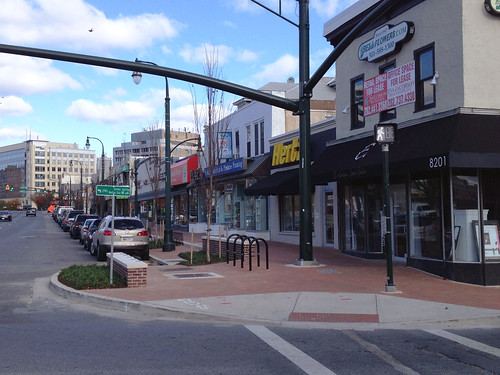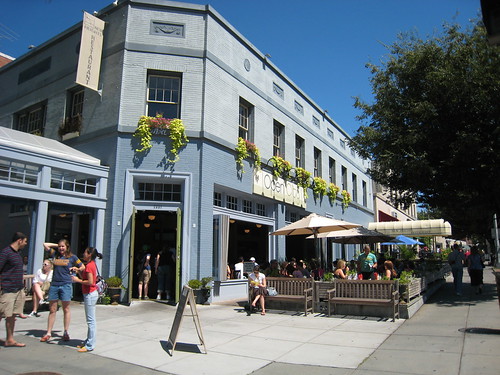The sidewalk on the east side of Georgia Avenue in downtown Silver Spring just got a makeover, with new brick pavers and street trees. But will it have enough room for everyone who wants to use it?
Montgomery County's Department of Housing and Community Affairs (DHCA) managed the $650,000 project, which began this summer and lasted about five months. The agency's main goal was to level and lower the sidewalk to meet the requirements of the Americans With Disabilities Act. It replaced the existing concrete sidewalk, built in the 1980s, with sturdier and more attractive brick pavers, and created large new bumpouts at some intersections.
The new sidewalk is very attractive and will hopefully encourage visitors and shoppers to stray from the Ellsworth Drive strip and check out the businesses on Georgia. But it also reveals the tension between different users on Silver Spring's often-cramped sidewalks.
DHCA also removed all of the mature Zelkova trees along Georgia, arguing that the sidewalk reconstruction would disturb the trees and kill them. The new trees are Princeton or Lacebark Elm trees, which will apparently improve the visibility of shops and restaurants from the street.
The old sidewalks had trees in tree grates, allowing room that businesses could put out tables and chairs and leave enough sidewalk for people to walk past comfortably. But the new trees now sit in long, wide planter boxes with little gaps in between for street lights or people getting out of parked cars.
This isn't the only place in downtown Silver Spring with new planters. The county's Department of Transportation (MCDOT) also installed the same planters along Ellsworth Drive and Fenton Street, except with three-foot-high hedges. Some planters, like one on Fenton Street, extend for most of a city block to discourage jaywalking.
In 2009, when planning on the Georgia Avenue sidewalk project started, county-hired arborist Steve Castrogiovanni recommended doing the same thing with the new trees to "strike a [balance] between the trees' needs and the needs of pedestrians." But officials endorsed the bigger planters, saying it would give the trees more soil and help them live longer.
Street trees have a lot of health and environmental benefits. They can provide a feeling of enclosure on a street or sidewalk, calming traffic on busy streets like Georgia Avenue. and making pedestrians feel safer.
However, these planter boxes seem to provide the wrong kind of enclosure. Crowded sidewalks can be a good thing, creating a feeling of excitement and vitality on a city street. But when you push pedestrians and outdoor dining tables into too small a space, it can feel uncomfortable, and people won't want to stick around and spend money.
That's why restauranteur Jackie Greenbaum, who owns Jackie's, Sidebar, and Quarry House Tavern, all on Georgia Avenue, didn't want trees planted on the narrow sidewalk outside her businesses. "THIS WILL ELIMINATE MUCH OF MY PATIO SEATING!" she wrote in a 2010 email to DHCA. "This is NOT an improvement and is unnecessary, even undesirable." In the end, DHCA agreed not to plant any there.
Having healthy street trees and vibrant sidewalks aren't mutually exclusive. DHCA could have still created a bigger soil pit for the trees, giving them room to grow, while putting tree grates or permeable pavers on top, ensuring that there's still enough sidewalk space.
And if county officials really wanted planters, they could have at least used a more attractive design, like these low, stone planters in NoMa that provide space for trees and plants while staying out of the way. Or they could have looked at a bioswale that cleans and filters stormwater in addition to looking pretty.
The real issue isn't the planters, but that the sidewalks on Georgia Avenue aren't appreciably wider. DHCA's project was simply to make the sidewalks meet ADA regulations.
This sidewalk may not get rebuilt for another 30 years, meaning we've missed an opportunity to have a larger conversation about how Georgia Avenue works. Wider sidewalks mean we wouldn't have to decide between landscaping, walking space, and outdoor seating. They mean we could have added new features, like benches, or a "shared use trail" for cyclists similar to the Green Trail on Wayne Avenue.
Doing this would require taking space for cars, which today constitutes the vast majority of Georgia Avenue, and giving it back to people. While that would probably be bad for drivers passing through, it would ultimately be a good thing for downtown Silver Spring, whose historic main street would become a more attractive, pleasant, and safer place to walk and spend time.
 |
| New brick sidewalks and street trees on Georgia Avenue. All photos by the author unless noted. |
Montgomery County's Department of Housing and Community Affairs (DHCA) managed the $650,000 project, which began this summer and lasted about five months. The agency's main goal was to level and lower the sidewalk to meet the requirements of the Americans With Disabilities Act. It replaced the existing concrete sidewalk, built in the 1980s, with sturdier and more attractive brick pavers, and created large new bumpouts at some intersections.
The new sidewalk is very attractive and will hopefully encourage visitors and shoppers to stray from the Ellsworth Drive strip and check out the businesses on Georgia. But it also reveals the tension between different users on Silver Spring's often-cramped sidewalks.
DHCA also removed all of the mature Zelkova trees along Georgia, arguing that the sidewalk reconstruction would disturb the trees and kill them. The new trees are Princeton or Lacebark Elm trees, which will apparently improve the visibility of shops and restaurants from the street.
 |
| The old sidewalks on Georgia last year. |
The old sidewalks had trees in tree grates, allowing room that businesses could put out tables and chairs and leave enough sidewalk for people to walk past comfortably. But the new trees now sit in long, wide planter boxes with little gaps in between for street lights or people getting out of parked cars.
This isn't the only place in downtown Silver Spring with new planters. The county's Department of Transportation (MCDOT) also installed the same planters along Ellsworth Drive and Fenton Street, except with three-foot-high hedges. Some planters, like one on Fenton Street, extend for most of a city block to discourage jaywalking.
In 2009, when planning on the Georgia Avenue sidewalk project started, county-hired arborist Steve Castrogiovanni recommended doing the same thing with the new trees to "strike a [balance] between the trees' needs and the needs of pedestrians." But officials endorsed the bigger planters, saying it would give the trees more soil and help them live longer.
 |
| A corner bumpout at Georgia and Silver Spring avenues. |
Street trees have a lot of health and environmental benefits. They can provide a feeling of enclosure on a street or sidewalk, calming traffic on busy streets like Georgia Avenue. and making pedestrians feel safer.
However, these planter boxes seem to provide the wrong kind of enclosure. Crowded sidewalks can be a good thing, creating a feeling of excitement and vitality on a city street. But when you push pedestrians and outdoor dining tables into too small a space, it can feel uncomfortable, and people won't want to stick around and spend money.
That's why restauranteur Jackie Greenbaum, who owns Jackie's, Sidebar, and Quarry House Tavern, all on Georgia Avenue, didn't want trees planted on the narrow sidewalk outside her businesses. "THIS WILL ELIMINATE MUCH OF MY PATIO SEATING!" she wrote in a 2010 email to DHCA. "This is NOT an improvement and is unnecessary, even undesirable." In the end, DHCA agreed not to plant any there.
Having healthy street trees and vibrant sidewalks aren't mutually exclusive. DHCA could have still created a bigger soil pit for the trees, giving them room to grow, while putting tree grates or permeable pavers on top, ensuring that there's still enough sidewalk space.
 |
| Wider sidewalks mean ample room for walking, for dining, and for nature. Photo by Jim Malone on Flickr. |
And if county officials really wanted planters, they could have at least used a more attractive design, like these low, stone planters in NoMa that provide space for trees and plants while staying out of the way. Or they could have looked at a bioswale that cleans and filters stormwater in addition to looking pretty.
The real issue isn't the planters, but that the sidewalks on Georgia Avenue aren't appreciably wider. DHCA's project was simply to make the sidewalks meet ADA regulations.
This sidewalk may not get rebuilt for another 30 years, meaning we've missed an opportunity to have a larger conversation about how Georgia Avenue works. Wider sidewalks mean we wouldn't have to decide between landscaping, walking space, and outdoor seating. They mean we could have added new features, like benches, or a "shared use trail" for cyclists similar to the Green Trail on Wayne Avenue.
Doing this would require taking space for cars, which today constitutes the vast majority of Georgia Avenue, and giving it back to people. While that would probably be bad for drivers passing through, it would ultimately be a good thing for downtown Silver Spring, whose historic main street would become a more attractive, pleasant, and safer place to walk and spend time.

3 comments:
I agree that the real issue is sidewalk width, not planters.
Pavers and grids gradually crush tree roots, and don't allow other plant life around the tree. Deep soil pits aren't feasible where they interfere with buried utilities. And shallow planters 1) don't provide additional space for sidewalk cafes, and 2) leave trees exposed to snowplows and snowbanks after severe storms.
The urban street tree issue is very complicated. Having just attend the Trees Matters Conference at the SS Civic building, I can attest that there are many opinions among urban planners and arborists on the best way to handle street plantings and about the tree choices made (Elms?!?), but all agree they are vital to our current and future quality of life.
It is very disappointing to hear that one business has the ability to nix plantings on a sidewalk that is publicly owned. It is true that the sidewalk is too narrow for cafe seating, plantings, and safe pedestrian passage. If having to choose among those three needs on an urban street, the LAST priority should be given to any private business.
BTW I cannot imagine a worse urban sidewalk planting than a bioswale -- talk about an ADA nightmare! Permeable pavers, such as the ones on Fenton, are also awful -- we, who have to walk there, call those the "ankle-breakers" and they do no favors to those tree roots.
Instead, I would like to see more large, raised planter beds and not at ankle-breaking height, but high enough to provide seating and real plant/tree protection as well.
Why do so many people see shared use trails as attractive when they have been found in study after study to be more dangerous?
http://ianbrettcooper.blogspot.com/2012/08/bicycle-infrastructure-studies.html
Post a Comment